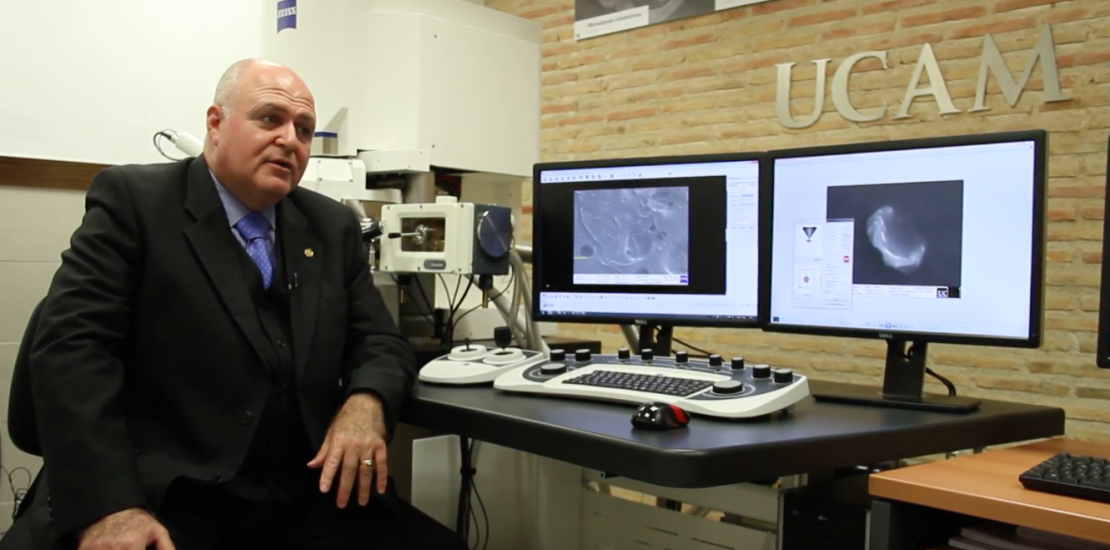Scientists identify the corpse shrouded in the Santa Sindone and the Shroud of Oviedo
A forensic- medical study performed in both the Shroud of Oviedo and the Sindone of Turin not only confirms that both linen clothes shrouded the same person , but also that this person, when it was already a corpse, suffered a penetrating wound that pierced the right hemithorax, with a deep cut entry in the fifth intercostal space and exit in the fourth one, close to the vertebral column and the right scapula, which also left signs of blood clots and pleural-pericardial liquid in both linen clothes
The studies about the Shroud of Oviedo are monitored by Alfonso Sánchez Hermosilla, a researcher in UCAM, the coroner from the Legal Medicine Institute of Murcia, headmaster of the Sindonology Research Spanish Center (EDICES) and researcher adviser in the International Sindonology Center in Turin. The research team is also integrated by Jesús García Iglesias, Mining Professor in the University of Oviedo, together with Marzia Boi, (EDICES member) Palinology and Biology expert, Juan Manuel Miñarro, Sculpture Professor in the University of Sevilla, Antonio Gómez Gómez, and Felipe Montero Ortego.
This statement concurs with the Gospel according to St. John, Chapter 19: verses 33-34: “But when they arrived at Jesus, as they saw he was dead, they did not break his legs, but one of the soldiers pierced with a lance on his side and at that moment blood and water flowed”.
The research has been carried out on anthropometric, criminalistic, anatomy and anatomic-pathological studies of the Sindone and the Shroud. The results show new advances of UCAM research team, which has been studying the Shroud of Oviedo for a long time and had previously found other evidence that support the fact that both linen clothes had shrouded the same person. The key for these last findings was the use of the Field Emission Scanning Electron Microscopy (FESEM), with the most advanced output, recently acquired by this University for this target among other. The researchers have performed studies with the FESEM on the blood, pollen presence, linen material preservation degree, as well as organic and inorganic pollutants.
According to Sánchez Hermosilla “blood stains in which we have worked, have always been there, but nobody had studied them and they are the only ones with such characteristics. Up to now, they had been attributed to marks caused by flagellation injuries”.
The marks observed by researchers, and in which the study is focused, share common characteristics and are very different from the rest, according to both hematic concentration in the center and a clearer and outlined on the borders. This stain also becomes invisible if observed under an infrared filter, as usual in stains from cadaveric blood, just the opposite to what happens with vital blood (punctate marks, for example, as a result of the injuries from the crown of thorns). There is on the Shroud another mark of similar characteristics called the “Accordion stain”, attributed to the same blemish origin and as a consequence of having folded the linen cloth several times in the shape of a loop, lying on the back of the great central stain.
In effect, the microscopic study of the samples, carried out with optic and electronic scanning microscopy, “shows the presence of structures compatible with highly damaged red blood human cells, some of them hemolyzed, and also with fibrin clots free from hematic structures”.
The forensic medical study describes in detail the tissues and organs the piercing object run through, in its hypothetical trajectory. It also adds that “particularly the heart right auricle, in cadavers of people that have suffered a long agony, very often present big blood clots, very similar to those that formed the side stain in the Sindone of Turin”, and also that “ in the piercing of the right lung, the weapon opened its way through the intraparenchymal sic airways, and as a consequence of this, part of the organic fluids made their way in a rising direction, due to the intrathoracic pressure, caused by the kinetic energy the weapon transmitted to the cadaver. These fluids also traveled through the cadaver’s mouth and nose and caused new stains in these areas of the Shroud of Oviedo. Of course, when the weapon was removed, these fluids went out through the entry-exit holes”.
The hypothesis that, who gave the “coup de grace” had experience, is like this endorsed, since when he placed the weapon blade in horizontal position, he could easily avoid the ribs without trying more than once, something that apparently did not happen, given that there are not, what is called in forensic medicine “feeling injuries”.
Before this new finding, and within the frame of this research, a grain of pollen was discovered in the Shroud of Oviedo. According to Marzia Boi, the EDICES palynologist this grain belonged to a plant that was compatible with theHelicrysum Sp., botanical species also identified in the Sindone of Turin. It was discarded the possibility of a later contamination since it was added to the blood, therefore, it arrived at the relic at the same time as the blood, not by chance.




